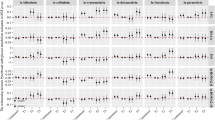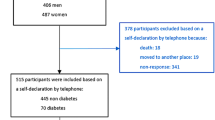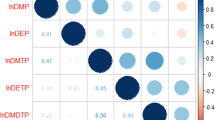Abstract
Pyrethroid insecticides have been extensively used worldwide, but few studies explored the prospective association between pyrethroid exposure and incident type 2 diabetes (T2D). We conducted a nested case–control study of 2012 paired cases and controls, and measured eight pyrethroid insecticides in the baseline sera. We used conditional logistic regression models to estimate odds ratios (ORs) with 95% confidence intervals, and constructed multiple-pollutant models to investigate the association of pyrethroid mixture with incident T2D risk. The median concentrations (detection rates) were 3.53 μg/L (92.45%), 0.52 μg/L (99.80%), 1.16 μg/L (90.61%) and 1.43 μg/L (99.95%) for permethrin, cypermethrin, fenvalerate, and deltamethrin, respectively. Compared to participants with serum fenvalerate levels in the first quartile, the multivariable-adjusted ORs of incident T2D were 1.20 (95% CI 0.86–1.67), 1.41 (0.97–2.05), and 2.29 (1.27–4.11) for the second, third and fourth quartile (P trend = 0.01). Spline analysis further confirmed the positive association between serum fenvalerate levels and incident T2D risk (P for overall association = 0.006). Furthermore, mixture models revealed a positive association of pyrethroid mixture with incident T2D risk, with serum fenvalerate ranked as the top contributor (proportion of relative contribution: > 70%). We found that high concentrations of serum pyrethroid insecticides were significantly associated with an increased risk of incident T2D. The elevated risk was largely explained by fenvalerate. Further investigations are urgently needed to confirm our findings and elucidate the underlying mechanisms, given the widespread use of pyrethroids and the global pandemic of diabetes.


Similar content being viewed by others
Data and materials availability
The full datasets used in this analysis are available from the corresponding author upon reasonable request.
References
Casida JE. Pyrethrum flowers and pyrethroid insecticides. Environ Health Perspect. 1980;34:189–202. https://doi.org/10.1289/ehp.8034189.
Zhu Q, Yang Y, Zhong Y, Lao Z, O’Neill P, Hong D, et al. Synthesis, insecticidal activity, resistance, photodegradation and toxicity of pyrethroids (A review). Chemosphere. 2020;254:126779. https://doi.org/10.1016/j.chemosphere.2020.126779.
Godin SJ, Crow JA, Scollon EJ, Hughes MF, DeVito MJ, Ross MK. Identification of rat and human Cytochrome P450 isoforms and a rat serum esterase that metabolize the pyrethroid insecticides deltamethrin and esfenvalerate. Drug Metab Dispos. 2007;35(9):1664. https://doi.org/10.1124/dmd.107.015388.
Sharma A, Shukla A, Attri K, Kumar M, Kumar P, Suttee A, et al. Global trends in pesticides: a looming threat and viable alternatives. Ecotoxicol Environ Saf. 2020;201:110812. https://doi.org/10.1016/j.ecoenv.2020.110812.
Williams MK, Rundle A, Holmes D, Reyes M, Hoepner LA, Barr DB, et al. Changes in pest infestation levels, self-reported pesticide use, and permethrin exposure during pregnancy after the 2000–2001 U.S. Environmental Protection Agency restriction of organophosphates. Environ Health Perspect. 2008;116(12):1681–8. https://doi.org/10.1289/ehp.11367.
Fang S, Yankun X, Mei H. The production and usage of pesticides of China in 2015 (in Chinese). Pestic Sci Adm. 2016;37(7):1–6. https://doi.org/10.3969/j.issn.1002-5480.2016.07.001.
Tang W, Wang D, Wang J, Wu Z, Li L, Huang M, et al. Pyrethroid pesticide residues in the global environment: an overview. Chemosphere. 2018;191:990–1007. https://doi.org/10.1016/j.chemosphere.2017.10.115.
Simaremare SRS, Hung C-C, Hsieh C-J, Yiin L-M. Relationship between organophosphate and pyrethroid insecticides in blood and their metabolites in urine: a pilot study. Int J Environ Res Public Health. 2020;17(1):34. https://doi.org/10.3390/ijerph17010034.
Wang X, Huang K, Zeng L, Zhang X, Cheng D, Li R, et al. Integration of 103 semivolatile organic compounds into one multianalyte method for human serum analysis: an innovative approach within exposure assessment. Environ Sci Technol Lett. 2021;8(5):419–24. https://doi.org/10.1021/acs.estlett.1c00285.
Diabetes Atlas, 10th edition. International Diabetes Federation. 2021. http://www.diabetesatlas.org/. Accessed 25 Jan 2022.
Zhang Y, Lazzarini PA, McPhail SM, van Netten JJ, Armstrong DG, Pacella RE. Global disability burdens of diabetes-related lower-extremity complications in 1990 and 2016. Diabetes Care. 2020;43(5):964–74. https://doi.org/10.2337/dc19-1614.
Vos T, Abajobir AA, Abate KH, Abbafati C, Abbas KM, Abd-Allah F, et al. Global, regional, and national incidence, prevalence, and years lived with disability for 328 diseases and injuries for 195 countries, 1990–2016: a systematic analysis for the Global Burden of Disease Study 2016. Lancet. 2017;390(10100):1211–59. https://doi.org/10.1016/S0140-6736(17)32154-2.
Zheng Y, Ley SH, Hu FB. Global aetiology and epidemiology of type 2 diabetes mellitus and its complications. Nat Rev Endocrinol. 2018;14(2):88–98. https://doi.org/10.1038/nrendo.2017.151.
Yousef MI, Awad TI, Mohamed EH. Deltamethrin-induced oxidative damage and biochemical alterations in rat and its attenuation by Vitamin E. Toxicology. 2006;227(3):240–7. https://doi.org/10.1016/j.tox.2006.08.008.
Muthuviveganandavel V, Muthuraman P, Muthu S, Srikumar K. A study on low dose cypermethrin induced histopathology, lipid peroxidation and marker enzyme changes in male rat. Pestic Biochem Physiol. 2008;91(1):12–6. https://doi.org/10.1016/j.pestbp.2007.11.010.
El-Demerdash FM, Yousef MI, Kedwany FS, Baghdadi HH. Role of alpha-tocopherol and beta-carotene in ameliorating the fenvalerate-induced changes in oxidative stress, hemato-biochemical parameters, and semen quality of male rats. J Environ Sci Health B. 2004;39(3):443–59. https://doi.org/10.1081/pfc-120035929.
Park J, Park SK, Choi YH. Environmental pyrethroid exposure and diabetes in US adults. Environ Res. 2019;172:399–407. https://doi.org/10.1016/j.envres.2018.12.043.
Starling AP, Umbach DM, Kamel F, Long S, Sandler DP, Hoppin JA. Pesticide use and incident diabetes among wives of farmers in the Agricultural Health Study. Occup Environ Med. 2014;71(9):629–35. https://doi.org/10.1136/oemed-2013-101659.
Hansen MR, Jørs E, Lander F, Condarco G, Schlünssen V. Is cumulated pyrethroid exposure associated with prediabetes? A cross-sectional study. J Agromed. 2014;19(4):417–26. https://doi.org/10.1080/1059924x.2014.945708.
Wang J, Zhu Y, Cai X, Yu J, Yang X, Cheng J. Abnormal glucose regulation in pyrethroid pesticide factory workers. Chemosphere. 2011;82(7):1080–2. https://doi.org/10.1016/j.chemosphere.2010.10.065.
Wang F, Zhu J, Yao P, Li X, He M, Liu Y, et al. Cohort profile: the Dongfeng–Tongji cohort study of retired workers. Int J Epidemiol. 2013;42(3):731–40. https://doi.org/10.1093/ije/dys053.
American Diabetes Association. Diagnosis and classification of diabetes mellitus. Diabetes Care. 2012;35(Supplement 1):S64–S71. https://doi.org/10.2337/dc12-s064.
Hornung RW, Reed LD. Estimation of average concentration in the presence of nondetectable values. Appl Occup Environ Hyg. 1990;5(1):46–51. https://doi.org/10.1080/1047322X.1990.10389587.
Hu FB, Rimm E, Smith-Warner SA, Feskanich D, Stampfer MJ, Ascherio A, et al. Reproducibility and validity of dietary patterns assessed with a food-frequency questionnaire. Am J Clin Nutr. 1999;69(2):243–9. https://doi.org/10.1093/ajcn/69.2.243.
Zhou B. Predictive values of body mass index and waist circumference for risk factors of certain related diseases in Chinese adults—study on optimal cut-off points of body mass index and waist circumference in Chinese adults. Biomed Environ Sci. 2002;1:83–96. https://doi.org/10.1046/j.1440-6047.11.s8.9.x.
Ma YC, Zuo L, Chen JH, Luo Q, Yu XQ, Li Y, et al. Modified glomerular filtration rate estimating equation for Chinese patients with chronic kidney disease. J Am Soc Nephrol. 2006;17(10):2937–44. https://doi.org/10.1681/asn.2006040368.
Benjamini Y, Hochberg Y. False discovery rate: a practical and powerful approach to multiple testing. J R Stat Soc Ser B Methodol. 1995;57(1):289–300. https://doi.org/10.1111/j.2517-6161.1995.tb02031.x.
Weber MB, Oza-Frank R, Staimez LR, Ali MK, Narayan KMV. Type 2 Diabetes in Asians: prevalence, risk factors, and effectiveness of behavioral intervention at individual and population levels. Annu Rev Nutr. 2012;32(1):417–39. https://doi.org/10.1146/annurev-nutr-071811-150630.
Lorenzo C, Nath SD, Hanley AJ, Abboud HE, Gelfond JA, Haffner SM. Risk of type 2 diabetes among individuals with high and low glomerular filtration rates. Diabetologia. 2009;52(7):1290–7. https://doi.org/10.1007/s00125-009-1361-4.
Hariri S, Yoon PW, Qureshi N, Valdez R, Scheuner MT, Khoury MJ. Family history of type 2 diabetes: a population-based screening tool for prevention? Genet Med. 2006;8(2):102–8. https://doi.org/10.1097/01.gim.0000200949.52795.df.
Li H, Lydy MJ, You J. Pyrethroids in indoor air during application of various mosquito repellents: occurrence, dissipation and potential exposure risk. Chemosphere. 2016;144:2427–35. https://doi.org/10.1016/j.chemosphere.2015.11.025.
Riederer AM, Hunter RE Jr, Hayden SW, Ryan PB. Pyrethroid and organophosphorus pesticides in composite diet samples from Atlanta, USA adults. Environ Sci Technol. 2010;44(1):483–90. https://doi.org/10.1021/es902479h.
Baden MY, Hu FB, Vetter C, Schernhammer E, Redline S, Huang T. Sleep duration patterns in early to middle adulthood and subsequent risk of type 2 diabetes in women. Diabetes Care. 2020;43(6):1219–26. https://doi.org/10.2337/dc19-2371.
Harrell FE. Regression modeling strategies: with applications to linear models, logistic and ordinal regression, and survival analysis. 2nd ed. Cham: Springer; 2015.
Bobb JF, Valeri L, Claus Henn B, Christiani DC, Wright RO, Mazumdar M, et al. Bayesian kernel machine regression for estimating the health effects of multi-pollutant mixtures. Biostatistics. 2015;16(3):493–508. https://doi.org/10.1093/biostatistics/kxu058.
Tanner EM, Hallerbäck MU, Wikström S, Lindh C, Kiviranta H, Gennings C, et al. Early prenatal exposure to suspected endocrine disruptor mixtures is associated with lower IQ at age seven. Environ Int. 2020;134:105185. https://doi.org/10.1016/j.envint.2019.105185.
Park S, Kim SK, Kim JY, Lee K, Choi JR, Chang SJ, et al. Exposure to pesticides and the prevalence of diabetes in a rural population in Korea. Neurotoxicology. 2019;70:12–8. https://doi.org/10.1016/j.neuro.2018.10.007.
Beard JD, Hoppin JA, Richards M, Alavanja MC, Blair A, Sandler DP, et al. Pesticide exposure and self-reported incident depression among wives in the Agricultural Health Study. Environ Res. 2013;126:31–42. https://doi.org/10.1016/j.envres.2013.06.001.
Bao W, Liu B, Simonsen DW, Lehmler HJ. Association between exposure to pyrethroid insecticides and risk of all-cause and cause-specific mortality in the general US adult population. JAMA Intern Med. 2020;180(3):367–74. https://doi.org/10.1001/jamainternmed.2019.6019.
Kim J, Park Y, Yoon KS, Clark JM, Park Y. Permethrin alters adipogenesis in 3T3-L1 adipocytes and causes insulin resistance in C2C12 myotubes. J Biochem Mol Toxicol. 2014;28(9):418–24. https://doi.org/10.1002/jbt.21580.
Go V, Garey J, Wolff MS, Pogo BG. Estrogenic potential of certain pyrethroid compounds in the MCF-7 human breast carcinoma cell line. Environ Health Perspect. 1999;107(3):173–7. https://doi.org/10.1289/ehp.99107173.
Kale M, Rathore N, John S, Bhatnagar D. Lipid peroxidative damage on pyrethroid exposure and alterations in antioxidant status in rat erythrocytes: a possible involvement of reactive oxygen species. Toxicol Lett. 1999;105(3):197–205. https://doi.org/10.1016/s0378-4274(98)00399-3.
Sun Q, Xiao X, Kim Y, Kim D, Yoon KS, Clark JM, et al. Imidacloprid promotes high fat diet-induced adiposity and insulin resistance in male C57BL/6J mice. J Agric Food Chem. 2016;64(49):9293–306. https://doi.org/10.1021/acs.jafc.6b04322.
Yan J, Wang D, Meng Z, Yan S, Teng M, Jia M, et al. Effects of incremental endosulfan sulfate exposure and high fat diet on lipid metabolism, glucose homeostasis and gut microbiota in mice. Environ Pollut. 2021;268(Pt A):115697. https://doi.org/10.1016/j.envpol.2020.115697.
Feriani A, Hachani R, Kaabi B, Ncir M, El Feki A, Allagui MS. Protective effects of Zygophyllum album extract against deltamethrin-induced hyperglycemia and hepato-pancreatic disorders in rats. Can J Physiol Pharmacol. 2016;94(11):1202–10. https://doi.org/10.1139/cjpp-2016-0132.
Fonseca A, Carvalho E, Eriksson JW, Pereira MJ. Calcineurin is an important factor involved in glucose uptake in human adipocytes. Mol Cell Biochem. 2018;445(1–2):157–68. https://doi.org/10.1007/s11010-017-3261-0.
Narra MR. Single and cartel effect of pesticides on biochemical and haematological status of Clarias batrachus: a long-term monitoring. Chemosphere. 2016;144:966–74. https://doi.org/10.1016/j.chemosphere.2015.09.065.
Montgomery MP, Kamel F, Saldana TM, Alavanja MC, Sandler DP. Incident diabetes and pesticide exposure among licensed pesticide applicators: Agricultural Health Study, 1993–2003. Am J Epidemiol. 2008;167(10):1235–46. https://doi.org/10.1093/aje/kwn028.
Ratelle M, Côté J, Bouchard M. Toxicokinetics of permethrin biomarkers of exposure in orally exposed volunteers. Toxicol Lett. 2015;232(2):369–75. https://doi.org/10.1016/j.toxlet.2014.12.003.
Perrier F, Giorgis-Allemand L, Slama R, Philippat C. Within-subject pooling of biological samples to reduce exposure misclassification in biomarker-based studies. Epidemiology. 2016;27(3):378–88. https://doi.org/10.1097/ede.0000000000000460.
Barr DB, Thomas K, Curwin B, Landsittel D, Raymer J, Lu C, et al. Biomonitoring of exposure in farmworker studies. Environ Health Perspect. 2006;114(6):936–42. https://doi.org/10.1289/ehp.8527.
Vernet C, Philippat C, Calafat AM, Ye X, Lyon-Caen S, Siroux V, et al. Within-day, between-day, and between-week variability of urinary concentrations of phenol biomarkers in pregnant women. Environ Health Perspect. 2018;126(3):037005. https://doi.org/10.1289/ehp1994.
Grimalt S, Harbeck S, Shegunova P, Seghers J, Sejerøe-Olsen B, Emteborg H, et al. Development of a new cucumber reference material for pesticide residue analysis: feasibility study for material processing, homogeneity and stability assessment. Anal Bioanal Chem. 2015;407(11):3083–91. https://doi.org/10.1007/s00216-015-8476-x.
Acknowledgements
We sincerely thank Y. Xu, L. Zhao, M. Wang, and Q. Tan from the School of Public Health, Tongji Medical College of Huazhong University of Science and Technology for their helpful suggestions in the experimental analysis and instrument operation. We are thankful to the laboratory staff who participated in our basic work. We especially appreciate all the participants involved in this study for the questionnaires and biological samples donated.
Funding
This study was supported by the grants from the National Natural Science Foundation (No. 82073656 and 81930092); the Fundamental Research Funds for the Central Universities, HUST (No. 2022JYCXJJ051); the Program for HUST Academic Frontier Youth Team (No. 2017QYTD18); and the National Key Research and Development Program of China (No. 2016YFC0900800 and 2017YFC0907500).
Author information
Authors and Affiliations
Contributions
CYJ, MAH contributed to conception and study design, completed data collection and laboratory analyses, performed analyses, interpreted results, and drafted and revised the manuscript critically. SYZ, XC, JA, XZ, and PWL participated in the data collection, laboratory analyses, and manuscript revision. WDL participated in the study design, method construction, result interpretation and manuscript revision. YY, HYZ, XMZ, HG, HDY, and TCW participated in the maintenance of the cohort, data analysis, and study design of the study. MAH and TJ were responsible for obtaining all necessary resources for the study and critically revised all manuscript drafts, including the final version. All authors gave final approval of the version to be published.
Corresponding author
Ethics declarations
Conflict of interest
The authors have no competing interests to declare that are relevant to the content of this article.
Ethical approval and Consent to participate
The project was approved by Ethics and Human Subject Committees of the School of Public Health, Tongji Medical College, Huazhong University of Science and Technology (2012–10), and all participants provided written informed consent.
Informed consent
Informed consent was obtained from all individual participants included in the study.
Additional information
Publisher's Note
Springer Nature remains neutral with regard to jurisdictional claims in published maps and institutional affiliations.
Supplementary Information
Below is the link to the electronic supplementary material.
Rights and permissions
Springer Nature or its licensor holds exclusive rights to this article under a publishing agreement with the author(s) or other rightsholder(s); author self-archiving of the accepted manuscript version of this article is solely governed by the terms of such publishing agreement and applicable law.
About this article
Cite this article
Jia, C., Zhang, S., Cheng, X. et al. Association between serum pyrethroid insecticide levels and incident type 2 diabetes risk: a nested case–control study in Dongfeng–Tongji cohort. Eur J Epidemiol 37, 959–970 (2022). https://doi.org/10.1007/s10654-022-00906-0
Received:
Accepted:
Published:
Issue Date:
DOI: https://doi.org/10.1007/s10654-022-00906-0




